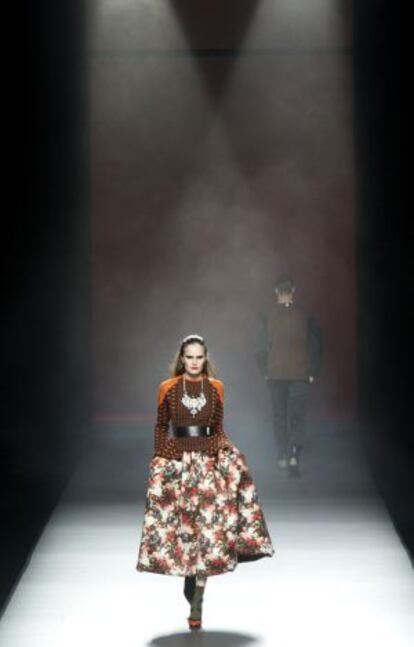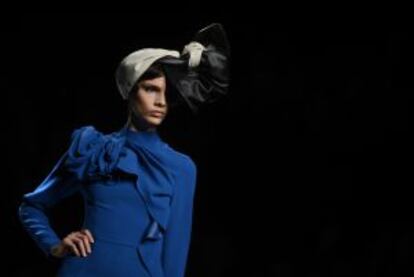Belt up: Fashion Week grapples with the economic crisis
Designers´ responses in Madrid range from the practical to escapism and nostalgia

“Through this collection I want to tell a story, my story, my world,” said María Barros, whose designs were featured in Tuesday´s lineup at the Mercedes-Benz Fashion Week in Madrid. This week´s show features some of Spain´s most notable designers and their Fall/Winter collections for 2013-2014. Though previous shows had also seen a designer´s worldview seep into his or her work, this year the creators’ perspectives on the economic climate within Spain seems to be a clear, overarching theme.
Barros’s designs feature bright yellows, fuchsias and greens, cinched waste lines and exuberant head pieces that are more reminiscent of Toulouse-Lautrec’s Parisian characters than the woman of this century. Barros attributes the inspiration behind her collection to the world of jazz. For Barros, the colorful, emotional and flamboyant world of jazz tells her story in fashion better than anything else. Her work is an escape; a step away from the dull and harsh reality that faces the fashion industry during these economically trying times, a sector of the public sphere that is without a doubt experiencing a surge of panic.
Barros´ exuberance is not the only artistic escape route during this week´s show. Brand Devota & Lomba describe the abstract and geometric nature of their collection as something that “counteracts noise… something that links us to our childhood.” Their designs are so abstract that they transform into something utopian. Doyo´s “Reservada” plays to the same idea of an optimistic past, a reflection on the joy and sensuality that defines the roots of Spanish culture, represented in deep merlot and burnt orange shades. Without directly referencing an escape, Hannibal and Laguna´s Monday show gave the audience a peak into a lens of luxury with flowing gowns in hues of emerald green and deep amethyst with bold and glamorous accents.
Other designers approached their Fashion Week exhibitions with a more practical perspective. Menswear designer Etxeberria, whose past collections had focused on a variety of aspects in fashion design (day wear, formal wear, outer wear, etc.), had realized that this approach “clashes with the social and economic realities of today.” This year´s collection features a line of structured outerwear coats that “works with a new rhythm of society; one that is more attentive to quality rather than mere consumerism.”

Davidelfin brought a collection of mixed-and-matched pieces in shades of black and white. The pieces have no distinct structure; they are left to lie on the body without any direct purpose. The collection, showing Wednesday, is titled “lost... missing,” one of the most pessimistic titles of this year´s show; but perhaps most indicative of the true status of the Spanish fashion industry. Many designers acknowledge that the climate is an unhealthy one and admit that in a country with a lack of jobs, there is a dying market for their creations. In an interview this week, Spanish designer Ana Locking attributed the survival of her brand to “fortunate” success within the United States and other European capitals.
Accompanying these visions of extreme practicality, pessimism or an escape, are designers who embraced the present reality with a sense of optimism and hope. Roberto Torreta´s collection focused on playing with structure to create an innovation that is fresh and creative, but still applicable to nature of everyday wear. Structured dresses in brilliant reds and retro patterns accompanied other ensembles of black leather: outfits that push the boundary between edgy and practical. Within the collection, there is a sense of power and creativity and rebellion, without omitting a solid reliance on classic structure.
Curiously, throughout a majority of this week’s featured designs, one trend seems to be consistent amid both optimistic and pessimistic designer visions: the prevalence of maxicinturones, or bold, exaggerated belts. More than just a sure fashion staple for this upcoming fall and winter season, this accessory provides a telling metaphor for this week’s Mercedes-Benz Fashion Week in Madrid: the belts of Spanish customers in this economic climate have tightened up, and designers are taking note.
Tu suscripción se está usando en otro dispositivo
¿Quieres añadir otro usuario a tu suscripción?
Si continúas leyendo en este dispositivo, no se podrá leer en el otro.
FlechaTu suscripción se está usando en otro dispositivo y solo puedes acceder a EL PAÍS desde un dispositivo a la vez.
Si quieres compartir tu cuenta, cambia tu suscripción a la modalidad Premium, así podrás añadir otro usuario. Cada uno accederá con su propia cuenta de email, lo que os permitirá personalizar vuestra experiencia en EL PAÍS.
¿Tienes una suscripción de empresa? Accede aquí para contratar más cuentas.
En el caso de no saber quién está usando tu cuenta, te recomendamos cambiar tu contraseña aquí.
Si decides continuar compartiendo tu cuenta, este mensaje se mostrará en tu dispositivo y en el de la otra persona que está usando tu cuenta de forma indefinida, afectando a tu experiencia de lectura. Puedes consultar aquí los términos y condiciones de la suscripción digital.
Últimas noticias
Mexico seeks to shore up its defenses following US incursion in Venezuela
Hope gives way to uncertainty among Venezuelan exiles in the US after Maduro’s capture
Cubans look to Venezuela fearfully after Trump’s incursion: ‘We could be next’
The operation in Venezuela to capture Maduro threatens to widen the cracks in the MAGA movement
Most viewed
- Alain Aspect, Nobel laureate in physics: ‘Einstein was so smart that he would have had to recognize quantum entanglement’
- Gilles Lipovetsky: ‘If you want to live better and fall in love, take Prozac, don’t look to philosophy’
- Alvin Hellerstein, a 92-year-old judge appointed by Bill Clinton, to preside over Maduro’s trial in New York
- Cuba confirms death of 32 of its citizens in the US attack against Venezuela
- Why oil has been at the center of Venezuela-US conflicts for decades








































